what causes a tomato stem to curl like a pigs tail (pics)
Hi,
All my 17 other varieties are giving me no trouble... and then there is my Sophie's Choice. As I've mentioned before, the leaves are just curling a bit every which way, but now I noticed that one of the plant has the top curled more than 360 degrees. The plant is about a foot tall, maybe a little taller. Has anyone seen this before?
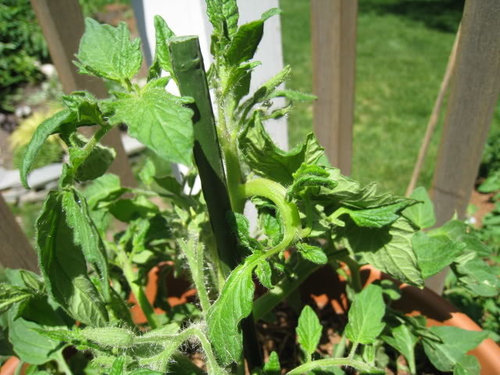
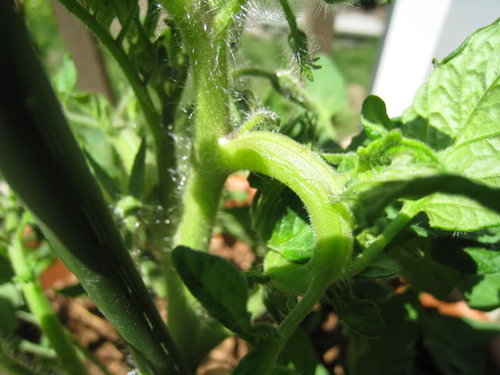
Some leaves are tightly caught in the twist. What the heck is going on?
Comments (93)
sodsouza51
7 years agoGorbelly,
i know I should wait my turn, but again reading back, I had to mention this. You are right on with the virus of seed borne diseases. Now that I remember, the previous cherry plant from which these 25 seedlings came, had the same shrivelling up of new shoots! but it was very minimal that it didn't draw much attention.
Related Professionals
Holly Springs Landscape Architects & Landscape Designers · Tempe Landscape Architects & Landscape Designers · Hartford Landscape Contractors · Bridgeport Landscape Contractors · Saint Paul Landscape Contractors · Tacoma Landscape Contractors · Annandale General Contractors · Franklin General Contractors · Mountlake Terrace General Contractors · Warren General Contractors · Winton General Contractors · Fort Worth Decks, Patios & Outdoor Enclosures · Hendersonville Decks, Patios & Outdoor Enclosures · Hull Decks, Patios & Outdoor Enclosures · Towson Decks, Patios & Outdoor Enclosuresgediminas6
7 years agoHello, it seems that I have the same problem with my tomato plants. I'm growing them in greenhouse and one fourth of them started to make curly and extremely thick branches, top parts of the stem are getting thick too. The first one is the worst example of my problem
The second plant has only one thick branch which is at the top of the plant and bumps at the bottom part of the stem ( I think that these are root bumps) and the bottom part of the stem is thinner that middle part. I believe that the reason why this is happening is because my node is too tight at the bottom tomato is tied and stem cant get thicker at that spot so plant is unable to transport enough water to the top parts and excess sugars stay at the middle of the stem and top branches thats why it gets thicker. But my father insists that its not the case and everything is ok and this tight node is not the reason why this is happening. I have to mention that this greenhouse was built two months ago. Last year when i was preparing this spot for it I used roundup to kill all folliage that was there.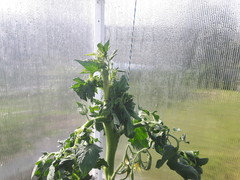
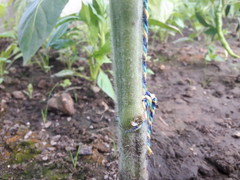
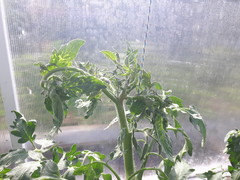
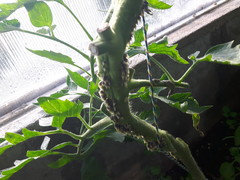
gorbelly
7 years agoWhat is the variety of tomato affected? Also, roundup causes damage that looks different, and roundup generally degrades after a couple of months. A year should be enough time for it to be rendered harmless, supposedly. That's not to say that it's impossible that that is roundup or some other herbicide damage, but it doesn't look like it to me. With adventitious roots, etc., maybe it's some kind of vascular disease or injury?
Labradors
7 years agoWhy not untie the string from the stem and attach it some other way? I string my plants up, greenhouse style, and just wind the string around and around. Amazingly, it doesn't need a knot.
It seems as if your plant is going through a lot of stress.....
Linda
gorbelly
7 years agolast modified: 7 years agoYes, I don't think the string is really the problem, but you should probably get rid of that now before the stem gets thicker. Tomatoes are very resilient. I had a plant with a major stem that was 80% severed, with what looked like only a flap holding it together, and the part of the plant after the break still continued to grow, flower, and produce fruit almost normally.
You could also try getting a deeper container and burying the stem several inches past the tied part. Additional roots will grow out from the buried stem.
Do all of the tomatoes with problems have a tight string around them at the bottom? What about the unaffected tomatoes?
Cboracle
7 years agoHi Gorbelly, I'm back. This years plant was from seed. Last years plant was a plant I picked up at the garden center. Both Early Girl's, both non GMO. I've always grown early girl's. I have grown them without issue prior, as well as Rutgers and July 4th's. I am producing tomatoes this year. Last year I had fruit but not as much as the previous normal years. No deformities in the tomatoes , as in they looked like normal tomatoes. Of them, they grew bigger then normal because plant was stunted, probably put all their energy in few tomatoes. I did have some with BER but fixed that. This year, my first flowers have six tomatoes growing on them now. My next set of flowers are just starting, 7 flowers, two of which are small tomatoes. One thing that is strange also is that each fruiting cluster stem has a big leaf on it. This also happened last year but never in previous years. My latest and 3rd set of flower clusters, the stem has divided in two and producing double flowers. This is a new one to me, as I haven't seen that before. Also has a big giant leaf on it. Pig tail has not gone extreme yet but still happening like corkscrews. Plant is about 3 feet and has seemed to not go any further in last two weeks. My last years tomato looked very much like gediminas6 plant. This year it is not as raveled but has all the same symptoms. I still have yet to do a soil test which I will do this week.
gorbelly
7 years agoIt's kind of a long shot. But you never know. With how centralized production is these days for things like plants and F1 seeds, it's possible that a seedborne disease could be out there widely distributed. and if it's not a well-known disease, it could just fly under the radar dismissed as a random oddity.
I've just been struck by how many of the pictures here look like textbook photos of bunchy top.
But let's be honest--it's more likely that Early Girl might have genetic predispositions to respond to certain stresses in this way.User
6 years agoHello. I believe that the issue is synthetic auxin contamination of the compost. This will persist for a long half life, so don't put on the garden after use.
I have had a three year battle with the major manufacturer of compost \ weedkillers \ etc who are US based but operate in the UK. After providing photo evidence and samples for analysis, they have finally admitted to contamination.
In the UK, people who have used this manufacturers compost have had whole domestic crops destroyed. Check the source of your compost materials, if it has recycled garden \ forest \ agricultural waste there is bound to be synthetic auxin contamination. If you are using manure form farms, auxin also persists in the dung from grass.
rgreen48
6 years agoI'm not sure I want to feed this topic, and I'm no fan of herbicides - never have I even once used one - but which synthetic auxin are you describing?
gorbelly
6 years agolast modified: 6 years ago"Synthetic auxin" is a class of herbicide. Very common. Dicamba, clopyralid, picloram, triclopyr and many other common ones. Widely used agriculturally/in landscaping and readily available at your local big box store. Compost and mulch contamination with them is a known problem.
But the epinasty in the photo could have been caused by, in a addition to the other possibilities mentioned in the thread, flooded roots and/or ethylene exposure (flooded roots prompts tomatoes to produce ethylene gas, to which they're very sensitive). If the plant went on to grow and produce well, it was probably environmental from root wetness. If the plant was stunted and produced poorly or took a long time after these symptoms to start producing normally again, it was probably herbicide exposure.
rgreen48
6 years agolast modified: 6 years agoYeah, but WHICH synthetic auxin? If there's legal action, or an event to which the manufacturer has admitted culpability - where evidence has been presented - then there is a record of the exact product at fault.
gorbelly
6 years agoDoes it matter? They all injure sensitive plants like tomatoes, right? The source probably depends on what's being composted. For example, if it contains forestry waste/wood, it's likely to have picloram in it. This is a known problem. That's why we always recommend on here that people who are buying mulch or compost test it before spreading it in the garden, even when it comes from a source they think they can trust. The fact is, those who are selling mulch and compost, even if they want to be responsible and ethical, have difficulty ensuring all of their sources are herbicide-free because the use of these chemicals is so widespread today and many in this class are slow to break down and can persist in compost and mulch for a year or more.
jonatcartwright is just warning people to check their compost because this is a problem. Others warn people about this well-known problem on these forums all the time. Why the negative attitude to his post?rgreen48
6 years agolast modified: 6 years agoBecause there are no specifics. I prefer specifics. There are a number of synthetic auxins, and there are many companies that sell composted wood products. I use wood products in my garden all the time. I am asking the auxin to which a manufacturer has admitted culpability. As I don't subscribe to unspecified fears, it is not unreasonable to ask for specifics. If there is evidence, present it and offer educated information to those interested in making informed decisions.
If there is evidence, then why question the presentation of that evidence?
Some undisclosed company had a spill of an undisclosed amount of oil in the Gulf... don't respond negatively, just accept our explanation. Does that sound like the proper response?gorbelly
6 years agolast modified: 6 years agoThe point is, this can become a problem with any purchased compost or mulch at any time with any number of herbicides, synthetic auxins and otherwise. It's a regular occurrence.
It's like doubting someone that warns that he was hit by a car at a known dangerous intersection. Whether or not that person was actually hit by the car, if we know that people are hit by cars at that intersection with frequency, isn't the warning to be extra careful when crossing that intersection still entirely valid?
And knowing which company and which synthetic auxin is like trying to know which driver hit which pedestrian at the dangerous intersection. It doesn't do much to mitigate the continuing danger, as the problem can happen at any time with any combination of pedestrians and drivers.PupillaCharites
6 years agolast modified: 6 years agoYou guys both have valid points. Can I agree with both? If the post had named the manufacturer, I also would have needed some documentation simply because the world is filled with people making baseless comments for a variety of reasons or even without reason. The name of the chemical would not be necessary for me, with another valid reference: a lawsuit mentioned the company itself received samples and then admitted guilt.
But because no manufacturer was named, no need to worry about an attempt to discredit any manufacturer. Because I can't evaluate the claim and it is no more powerful to me in an argument than someone who walks up to me and says they were hit by a car in a busy intersection, but look healthy to me. I believe them in a social sense, and that's it.
In no way does that mean I should be skeptical of the claim, any more than anything else in the torrent of information I receive daily. However, the claim of synthetic auxin was made by the poster, but the manufacturer could have found high concentrations of copper for all I know and just went along in the scenario of the posted lawsuit. So until the results of an analysis are shared, I'm on the fence but appreciate the helpful tip to be vigilent.
Very often things aren't what they seem ...
Cheers
PC
albert_135 39.17°N 119.76°W 4695ft.
6 years agoI do not know how current this is. ''Naphthalene acetic acid (NAA) is a purely synthetic auxin.
It is chemically similar to IAA in structure but is a more effective
auxin in promoting rooting. It is commonly found in commercial rooting
compounds and is often combined with IBA." I recall ir was very common in rooting compound products several decades ago. I have no knowledge of it's current status.User
6 years agoHello All. Year 1 manufacturer denied any issues. Year 2 manufacturer denied but later admitted contamination by weed-killer in the compost following analysis, but declined to name the exact type stating 'The green waste in
the compost was found to have a small trace of a herbicide, that's all the
information we are able to provide'.Year 3 manufacturer again denies presence of symptoms despite photographic evidence, stating a five fold increase in source testing. Symptoms are less severe this time. Compost samples have again been submitted for analysis.
The symptoms (leaf curl, leaf elongation, cupping and fern fronding, Swellings and distortion, cloud flower formation etc) each year have resembled that caused by pyridine carboxlic acids (Clopyralid, picloram etc). The company was Scott Levington aka Scotts Miracle-Grow Company.
gorbelly
6 years agoPersistent Herbicide FAQ from US Composting Council
At this point, I would personally never apply compost or mulch from a source that I did not control without doing a bioassay on it first.
Article from Rodale's on how to do your own bioassay.rgreen48
6 years agoThank you very much jonatcartwright. See, how easy that was? Now we have information. Now, as informed individuals, we can choose to form an opinion and act responsibly.
As I mentioned, there are a number of synthetic auxins. 2, 4-D is an example. As I said, I don't use herbicides AT ALL. I don't use any 'cides. That is my INFORMED choice. However, I am aware that some products are more persistent than others. The difference between 2, 4-D, and this type mentioned, is PERSISTENCE under 'normal' circumstances. 2, 4-D (again, under normal conditions) has a very fast half-life. In a few weeks, exposed to soil bacteria, it's pretty much metabolized to insignificant levels.
Now... what does this information do for me? I live in a rural area. The guy across the street has miniature horses and tosses the manure in a field up the hill from my garden. I asked him, and he gets his hay from the local Farmer's Coop. All I have to do is ask them who supplies their hay and if herbicides are used. The hay farmers here are mostly small farm owners who sell their hay to local small angus beef farmers, and horse owners. We are a hilly region, and we have few large hay producers. Therefore, few use herbicides.
I can now simply ask, and if the answer comes back as products containing pyridine carboxlic acids as active ingredients, I can make an informed choice to avoid that particular persistent chemical. I can also choose to boycott the manufacturers of those chemicals and the composted products (which I basically already do to the extent that it's possible.)
I personally do not favor the consumer-driven approach that comes with ignorance. I AM NOT GOING TO BUY A COMPOST OR SOIL PRODUCT AND LET IT SIT AND COMPOST FOR ANOTHER 6 MONTHS TO A YEAR! [caps used for emphasis, not yelling.]
Instead... I, and for that matter, the US Compost Council, favor a supplier-driven approach to dealing with the problem of contaminated compost and manure. It should be incumbent on suppliers to specifically deal with known issues of potential contamination... especially as the use of these products increase. And, even though there are warnings on the labels, no one should use these products without knowledge of the potential harm caused to neighbors and the future harm to end users of any product containing a contaminated ingredient.
I said right off with my first comment that I hesitated to even approach the subject knowing that people get all weird when people ask reasonable questions.User
6 years agoJust so you can all see the symptoms I am uploading last years severe fern fronding, and this years leaf curl.
The symptoms last year indicate severe contamination. This year low level presence is indicated but it is severely restricting lead growth.
Last year I tried two purchases of compost. We identified the problem batches by serial number.
This is my observation passed to the manufacturer on first planting failure. Second planting had similar result.
2016 photo
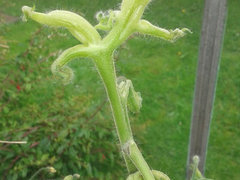
'It may assist your laboratory staff to be made aware that before
disposing of the plants I made a thorough examination of the remaining leaf
material. The root systems appeared to be forming normally with no obvious
defect \ sign of infestation \ fungus or deformity.The result of visual examination were as follows:
Enlarged root forming nodules at base of plant.Accelerated cell division characteristics at leaf nodes creating
a thickened surface layer.Leaves at lower levels showed slight damage symptoms which
increased to severe at 4’ growth.Upper leaves showed increasing curl, eventually forming growing
fern like unopened fronds.Lead shoot distorted to a club like appearance.
I could find no obvious symptom of known virus, or the effects
of infestation or fungal attack.
Phytotoxic effect caused by external factors such as drift \
mineral imbalance \ salinity can probably be discounted, as all of the plants
(raised and \ or kept together) and not planted in the relevant batches of
compost are thriving and healthy.
The symptoms are similar to synthetic
auxin herbicides such as aminopyralid, clopyralid, and picloram
contamination of soil.
I believe that these volatile compounds can evaporate from leaf
areas and remain as an active contaminant for over a year. I don’t think
composting the affected plants or digging the bag compost into the veg patch is
a good idea!'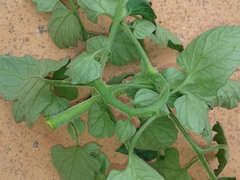
User
6 years agoMy posts have made in good faith because I was (and am) very disappointed at the level of carelessness by the manufacturer. People should be made aware of these issues.
I am not a litigious person and believe that Public response by non-purchase is more effective when you are trying to deal with a company so large that it can plan to 'Invest' $500 million in 'Hydroponics Cultivation'.
Signing off, and good luck
gorbelly
6 years agolast modified: 6 years agoPersonally, I would ALWAYS advise people to test purchased compost and mulch themselves before applying it.
Suppliers can only address problems they're aware of. Recalls never retrieve 100% of bad product, especially with something that isn't sickening people. And it's too easy to end up a victim of inadvertent herbicide exposure by trusting that the system will work in your favor--it doesn't and it won't.
It's a common enough problem that consumer vigilance and action are also called for. Getting mad at the supplier won't fix a ruined growing season.
Chippah
5 years agoI have a pig tail curls on all of my Tomatoes all varieties. Both in Beds, in containers, aswell as the wild one I plant directly into my lawn for the squirrels and birds to enjoy. Also all have purpling at the joints of newer growth.
because of our unseasonable weather when transplanting a month ago it was in 30's(celsius) which is really warm for this time of year in my zone (5B). They were well hardened off at that point so they seemed to do very well. But this last week our temp has returned to what we expect for this time of year of 15-20 degrees C.
My thoughts were maybe the drop in temp are stressing them out. I haven't fed them in about 2 weeks as well but i'm about to do that after i press submit.Picture included
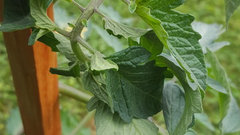
gorbelly
5 years agoEpinasty can also be caused by excessive water in the root zone. I'm not sure where you are geographically, but where I am, May was almost a solid month of nonstop rain, and a lot of people around here complained about their plants curling and drooping.
Chippah
5 years ago@gorebelly not much rain in may, we had a few heavy days but it was more crazy hot and humid than anything else. Also the plants don't have any droop they are very perk and look rather healthy other than the pig tail and purpling at joints
fungus
5 years agoThe lower temps are leading to a more (excessive) vegetative growth (you overdid the fertilization a bit). Those leaves will look a bit gnarled when old, but they will uncurl. After fruits start growing such growth is rare (the plant will not have the energy for excessive growth since it has the fruits to grow). Also flowers in this period sometimes pollinate but don't grow (they stay there but don't fall off) and sometimes get activated later on.
Mac
4 years agoHi everyone, in my search to find out what is going on with my 20 tomato plants, I came across this thread discussing the exact same symptoms. Stunted growth, new top growth small and curly, main stems fat on the top half and thin on the lower half. Large, dark green lower foliage. I've run through the gambit of extension disease lists, at one point thinking maybe its curly top virus, We live on 87 acres surrounded by trees, and do everything organically, so I ruled out herbicide drift. Unless the drift happened at the organic greenhouse I picked up the transplants from. Did anyone here come to some sort of conclusion on what they were dealing with, and did your plants survive from it? Any insight or help would be greatly appreciated. Thanks!
gorbelly
4 years agoDid you apply any mulch or manure recently? Also, photos would help, both of the entire plant affected and a closeup of the stunted newer growth.
Mac
4 years agoThanks Gorbelly for the response. The soil was amended with a product here in Michigan from Morgan's Organic composting called "Dairy-doo." Which is basically heated cow manure. We used pine needle mulch gathered from our own pine trees. The plants were all doing great until about a week ago when the growth stunted, leafs curled, and branches started growing downward. Thanks for your time and help!
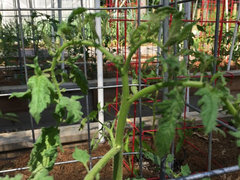
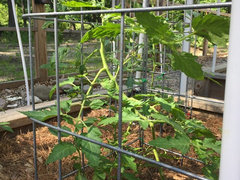
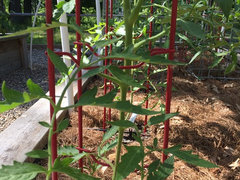
Mac
4 years agoAll 20 of the different heirloom varieties I'm growing are showing varying degrees of these symptoms. Some of the stem's are getting even fatter than the photos shown.
gorbelly
4 years agoAlso, please let us know your location and how the weather has been in the past couple of weeks.
Mac
4 years agoWe are in zone 6, in a city outside of Kalamazoo Michigan. Southwest part of the state. The weather has been abnormal, with cold nights and warm days. Its only until this past week that the nights have warmed up. Raining consistently every two days but our tomatoes are kept dry underneath a tent made of 6mil greenhouse film. Thanks again!
gorbelly
4 years agoYour plants look normal to me. Maybe a bit curly due to rain, maybe a little too much N from the Dairy Doo? I'm not familiar with the composition of that product. But weird temps can certainly affect new growth. It's also quite normal for tomato stalks to be thicker a foot or two above the ground, depending on variety. It can be exacerbated by flooding conditions, so even if your plants themselves are protected, if the soil under them is prone to waterlogging, it could be triggering some epinasty. These aren't serious problems--just make sure the tent gets good ventilation and don't overwater, make sure the food they get isn't too high in N, and I'm sure the plants will do just fine.
Kim Peacock
2 years agolast modified: 2 years agoMy partner and I are trying to figure out what happened to our tomatoes, and this thread has been so helpful. By the photos posted, we think it's herbicide damage, but don't know how it could have happened as these seedlings were grown indoors. The only thing we can think of is that there was some in the bag of Pro-Mix we used. Does anyone have any thoughts, based on the photos below?
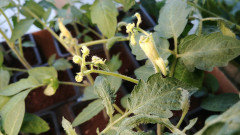
gorbelly
2 years agoI would suspect nutrient deficiency more than herbicide for these plants. What are you feeding them?
Labradors
2 years agoDid you use a fertilizer on these plants? I WOULD suspect a herbicide going by the "clubbing" in the pictures.
LindaKim Peacock
2 years agoNo, we haven't given them any separate fertilizer. We planted them in the specialized tomato and herb Pro Mix and then after 2 months gave them each a tablespoon of coffee grinds, which is the same thing we've done for years now. By comparison, we didn't quite have enough Pro Mix for the batch and planted 3 in normal household potting soil, and they're doing just fine (at least we'll have three plants this year). All are heirloom varieties, if that helps.
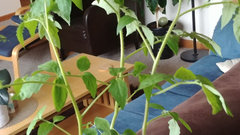
Labradors
2 years agoThat's rather a shock that it appears to be the Veg and Herb Pro Mix! I asked because a friend had similar problems due to trying a new fertilizer. My friend's seedlings were small enough that she was able to re-plant some of them in fertilizer-free potting mix.
LindaGraham O'Neill
2 years agoHello - I seem to be getting something very similar to the curly stems and shriveled new growth that folks are seeing above. Any idea what it might be?
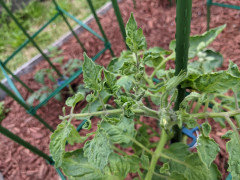
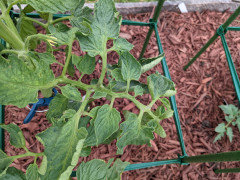
nicolemorris
2 years agolast modified: 2 years agoMine are looking exactly like yours, @Graham O'Neill. I'm growing 13 different kinds and 12 of them, all except my one and only determinate type, are super thick and super curled. I'm getting fruits showing on some already though. I started all mine from seed. I've never had this happen whenever I've purchased plants before but I'm experimenting doing it all myself start to finish this year. I'm hoping I get at least some from each. I'm Kentucky zone 6b and it has been weirdly wet the last few weeks, then it was super hot and humid the last week. Incidentally, I'm using the same tomato supports this year. Again, a first. Have you used them previously?
ETA @gorbelly I've not used any fungicides, and the only herbicide was Captain Jack's dead weed brew on weeds in my shade garden about 100 feet away, sprayed on a calm day. I have been pinching suckers religiously on all my indeterminates, which are the 12 that are curling, so is there any chance I'm just screwing them up by not leaving them alone?gorbelly
2 years ago@Graham O'Neill, your first pic looks like it might be herbicide injury or a virus, but it's borderline. Could also be something nutrition/water related or physiological. The rest of the photos look like Physiological Leaf Roll, something that happens to tomato plants during times of stress and really is hard to avoid and has no solution, but it also doesn't seem to do much harm to the plant. Lastly, I'd check for aphids and other sap-sucking pests on the undersides of the leaves. Sometimes, that can cause distortion and curling.
@nicolemorris, sometimes excessive pruning can cause curling, especially if the plants are getting too much water. If you've been pruning a lot and getting a lot of rain, that could cause it. Excess nitrogen can do it, too. If the flowers coming in are looking normal, maybe it could be OK.Graham O'Neill
2 years ago@gorbelly - the same curling happened a few other plants in the same plot common to the point where I put in a different set of seedlings. It hasn't seen me come back, but might be happening on another one that's an original planting. I've looked and thought it might be aphids, virus, or herbicide as well, but I'm not sure because I'm in a community garden and there are tomatoes all around me that aren't suffering from the same thing.
I'm really starting to think it's might be over-watering, over fertilizing or over pruning, because all the other tomatoes around me much less are much less fussed over. I've taken to spraying the plants every week with neem oil in case it's bugs or a fungus, and making sure I only water when the soil underneath the mulch is damp. Other than that I'm just leaving them alone as I can't think what else I can do?
@gorbelly - what else is it borderine with?
@nicolemorris - Yep this is the first time I've used the tomato supports. Seem a bit more sturdy than the wire cages I've used before.Graham O'Neill
2 years ago@gorbelly - the same curling happened a few other plants in the same plot common to the point where I put in a different set of seedlings. It hasn't seen me come back, but might be happening on another one that's an original planting. I've looked and thought it might be aphids, virus, or herbicide as well, but I'm not sure because I'm in a community garden and there are tomatoes all around me that aren't suffering from the same thing.
I'm really starting to think it's might be over-watering, over fertilizing or over pruning, because all the other tomatoes around me much less are much less fussed over. I've taken to spraying the plants every week with neem oil in case it's bugs or a fungus, and making sure I only water when the soil underneath the mulch is damp. Other than that I'm just leaving them alone as I can't think what else I can do?
@gorbelly - what else is it borderine with?
@nicolemorris - Yep this is the first time I've used the tomato supports. Seem a bit more sturdy than the wire cages I've used before.MK
2 years agoI'm quite sure after reading this thread that i have an answer for my early girls, which are all doing this thick leaf stem growing upwards and twisting (more like a sucker would do), with large, thick leaves that are also turning upwards and rolling/twisting. There is zero discoloration or otherwise poor health indications, i grow in the middle of 50 acres, totally organically, my own compost used, mulched with wood chips a year old from within the property. I've used zero pesticides, herbicides or fertilizers. Just compost, coco coir, water and my seedlings. They aren't stunted, are growing quite fast actually but, here in Northern California in the Sierra Nevada mountains we've seen record breaking temps between 90-105 for a few weeks straight now and I'm pretty certain my plants are just tired of baking. I'm hanging shade cloth tomorrow and will post pictures as well because it's quite bizarre how hearty they are but growing like an upside down tipi (and it's only my early girls doing this, the other varieties are all fine.)
MK
2 years agoI was wrong, it's not my early girls, but one of my 'unidentified' heirloom tomatoes that i lost my tag for. The leaves are growing really weird and looking like they're trying to sprout suckers down the stems of the sun leaves in some spots, i think it's curly top virus unfortunately.
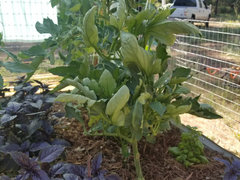
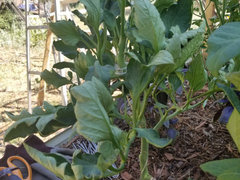
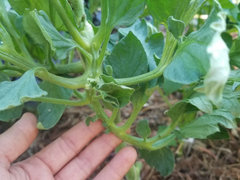
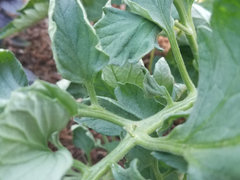
















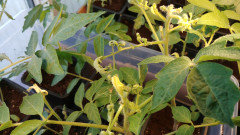
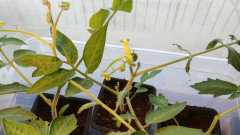
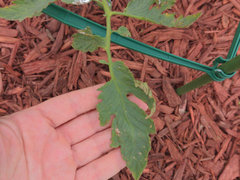
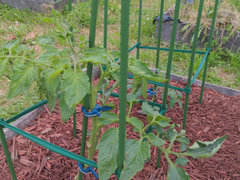
Mac